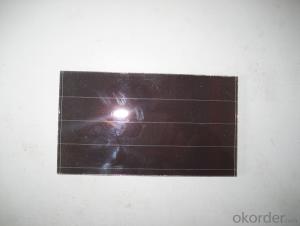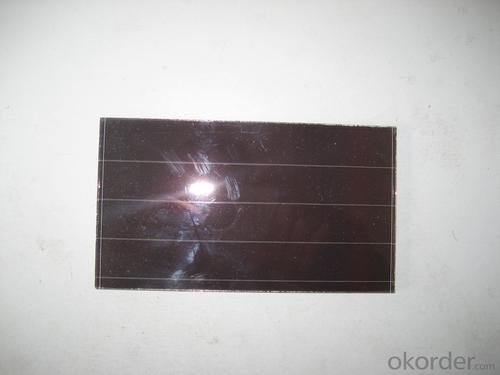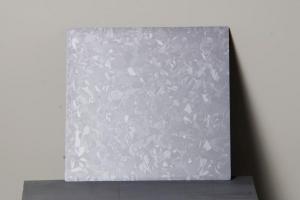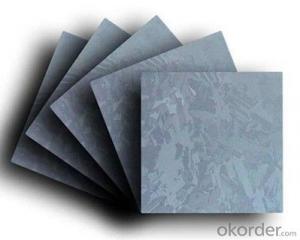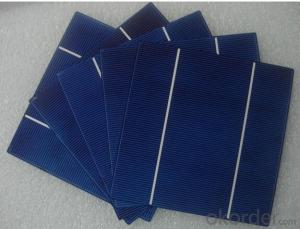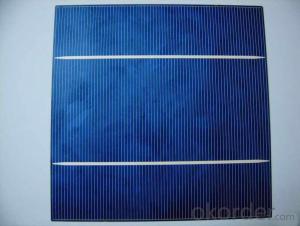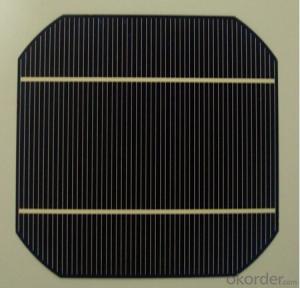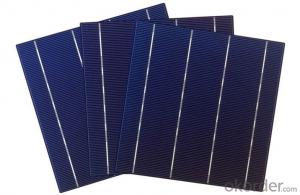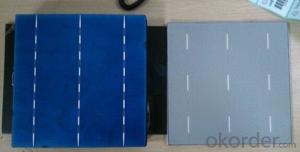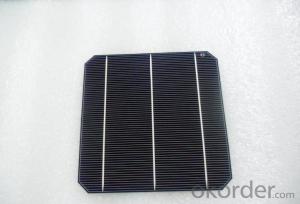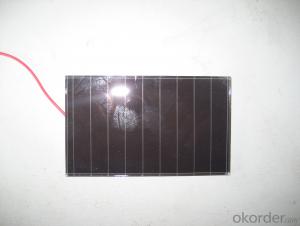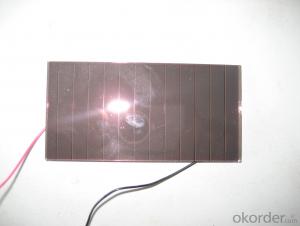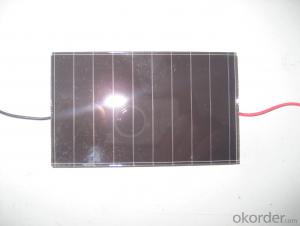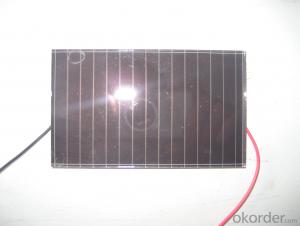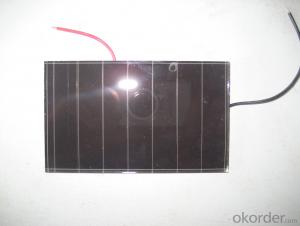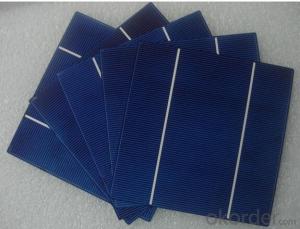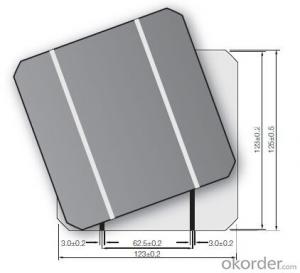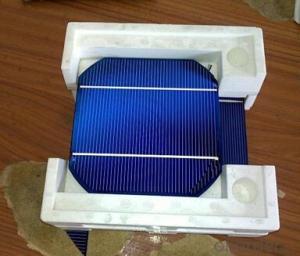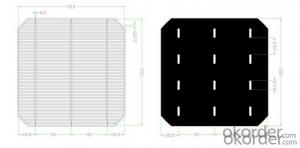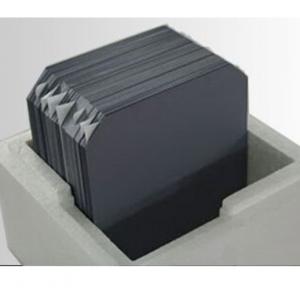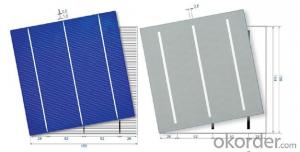Amorphous Silicon Dice Silicon Wafer Solar Panel Specification 1
- Loading Port:
- China Main Port
- Payment Terms:
- TT OR LC
- Min Order Qty:
- -
- Supply Capability:
- -
OKorder Service Pledge
OKorder Financial Service
You Might Also Like
Pv modules at present, the mainstream products are still in silicon as the main raw materials, only in terms of silicon raw material consumption, production 1 mw of crystalline silicon solar cell, need 10 to 12 tons of high purity silicon, but if use the same silicon materials used to produce thin film amorphous silicon solar cell can produce more than 200 mw.
From the perspective of energy consumption, amorphous silicon solar battery only 1-1.5 years of energy recovery period, more embodies its contribution to energy saving in the manufacturing process.
Component occupies a high proportion of costs in a photovoltaic system, the component prices directly affect the system cost, and thus affect the cost of photovoltaic power generation. Calculated at the current price of components, the same money, buy amorphous silicon products, you can get more close to 30% of the power components.
2, more power
For the same power of solar cell array, amorphous silicon solar cell is about 10% more than monocrystalline silicon, polycrystalline silicon battery power. This has been the Uni - Solar System LLC, Energy Photovoltaic Corp., Japan's Kaneka Corp., the Netherlands Energy research institute, and other organizations and experts confirmed that the Photovoltaic industry.
In sunny, that is to say, under the high temperature, amorphous silicon solar cell components can show more excellent power performance.
3, better low light response
Due to the characteristics of amorphous silicon atoms are arranged disorderly, the electron transition no longer comply with the restriction of traditional \"selection rule\", as a result, its light absorption characteristics and there are big differences monocrystalline silicon material. Amorphous silicon and monocrystalline silicon material absorption curve as shown
, amorphous silicon absorption curve has obvious three sections (A, B, C). Area A corresponding electronic transition between localized states, such as the gap state near Fermi level and to the tail state transition, the absorption coefficient is small, about 1-10 cm - 1, for this is absorbing; B area absorption coefficient with the increase of the photon energy index rose, it corresponds to the electrons from the valence band edge extension state to the conduction band localized state transition, as well as the localized electrons from the valence band tail states guide for edge extension state transition, the region's energy range is usually only about half of the electron volts, but absorption coefficient across two or three orders of magnitude, usually up to 104 cm - 1; Area C corresponds to the electrons from the valence band to the conduction band internal internal transition, the absorption coefficient is bigger, often in more than 104 cm - 1. After two absorption area is crystalline silicon eigen absorption area.
Can be seen in the figure, the intersection of two curves about 1.8 ev. It is important to note that in the visible light range (1.7 to 3.0 ev), the absorption coefficient of amorphous silicon material is almost an order of magnitude larger than the single crystal silicon. That is to say, in the morning the first part of the sun is not too strong, the second half, and it's cloudy in the afternoon under the condition of low light intensity, long wave is greater, the amorphous silicon material still has a large absorption coefficient. Again considering the amorphous silicon band gap is larger, the reverse saturation current I0 is smaller. And as mentioned the amorphous silicon battery the characteristics I - V characteristic curve of the amorphous silicon solar cell both in theory and in practical use in low light intensity has good adaptation.
• I - V characteristics of amorphous silicon cells after more than a Vm with the voltage drop slowly
In order to be convenient, we draw the I - V characteristics of two kinds of batteries on the same picture. Crystalline silicon and amorphous silicon battery I - V characteristics of general shape as shown
we see from the picture, two kinds of cells in the curve changes after exceed the maximum output power point gap is bigger. Output current of crystalline silicon cells after exceed the maximum output power point will soon fall to zero, curve steep; Rather than crystalline silicon cells output current after a long distance to fall to zero, the curve is relatively flat. Two kinds of battery Vm equivalent to about 83% of its open circuit voltage and 83% respectively.
when light intensity gradually become hour, short circuit current and open circuit voltage of solar battery will be stronger. Short circuit current decreases faster, of course, open circuit voltage decrease more slowly.
do in battery solar cell array under the condition of load, when the sun battery array of effective output voltage less than the terminal voltage of battery, battery cannot be recharged. When the light intensity gradually become hour, crystal silicon battery charging does not meet the conditions, and amorphous silicon due to the larger voltage difference, do not charge until the light is very dark, effectively increase the use of sunlight time. So, amorphous silicon cells to produce more electricity than the crystalline silicon.
4, more excellent high temperature performance
High in the outdoor environment temperature, amorphous silicon solar cell performance change, depends on the temperature, spectrum, as well as other related factors. But what is certain is: amorphous silicon than monocrystalline silicon or polycrystalline silicon are less likely to be affected by temperature.
Amorphous silicon solar cells than monocrystalline silicon, polycrystalline silicon cells have relatively small temperature coefficient of amorphous silicon solar cell output power best Pm temperature coefficient is about 0.19%, and monocrystalline silicon, polycrystalline silicon cells best output power Pm temperature coefficient is about 0.5%, when the battery work at higher temperatures, the two batteries will be a drop in the Pm, but the decline is different. They can be calculated using the following formula.
- Q: How does the texturing process affect the performance of a solar silicon wafer?
- The texturing process significantly affects the performance of a solar silicon wafer. By creating a rough surface on the wafer, texturing increases the light trapping capability, allowing for better absorption of sunlight. This increased light absorption enhances the efficiency of the solar cell, leading to improved performance and higher power output. Additionally, the textured surface reduces the reflectivity of the wafer, ensuring that more light is absorbed rather than being reflected away. Consequently, the texturing process plays a crucial role in enhancing the overall performance and efficiency of solar silicon wafers.
- Q: What is the impact of temperature on the performance of solar silicon wafers?
- The performance of solar silicon wafers is significantly affected by temperature. Higher temperatures can lead to decreased efficiency and power output of the solar cells. This is because increased temperature can cause an increase in the electrical resistance of the wafers, reducing their ability to convert sunlight into electricity. Additionally, higher temperatures can also accelerate the degradation and aging of the solar cells, reducing their overall lifespan. Therefore, maintaining lower temperatures or implementing cooling mechanisms is essential to optimize the performance and longevity of solar silicon wafers.
- Q: How is an anti-reflective coating applied to a solar silicon wafer?
- An anti-reflective coating is typically applied to a solar silicon wafer through a process known as chemical vapor deposition (CVD). In this process, a thin layer of silicon nitride or titanium dioxide is deposited onto the surface of the wafer using a gas-phase reaction. The wafer is exposed to a precursor gas containing the desired coating material, which then reacts and forms a thin film on the surface. This coating helps to reduce the reflection of sunlight, allowing more light to be absorbed by the solar cells and increasing their efficiency.
- Q: How are solar silicon wafers protected from static electricity damage?
- Solar silicon wafers are protected from static electricity damage through various measures such as grounding the equipment and personnel, using anti-static packaging materials, employing ionization techniques to neutralize static charges, and implementing proper handling procedures to minimize the risk of electrostatic discharge.
- Q: What is the thickness of a solar silicon wafer?
- The typical thickness of a solar silicon wafer is around 200 to 300 micrometers.
- Q: How are solar silicon wafers affected by surface passivation techniques?
- Surface passivation techniques can significantly improve the performance and efficiency of solar silicon wafers. These techniques involve applying a thin layer of passivating material, such as silicon nitride or aluminum oxide, to the surface of the wafers. This layer helps to reduce the recombination of charge carriers at the surface, which in turn reduces losses and improves the overall efficiency of the solar cell. Additionally, surface passivation techniques also enhance the electrical properties of the solar silicon wafers, leading to better performance and longer lifespan of the solar cells.
- Q: How are solar silicon wafers integrated into the electrical grid?
- Solar silicon wafers, which are the key component of solar panels, are integrated into the electrical grid through a series of steps. First, the solar panels made from silicon wafers are installed on rooftops, open spaces, or solar farms where they can capture sunlight. The panels convert sunlight into direct current (DC) electricity. To integrate this DC electricity into the electrical grid, an inverter is used to convert the DC electricity into alternating current (AC) electricity, which is the form of electricity used in the grid. The AC electricity produced by the solar panels is then connected to the electrical grid through a bi-directional meter. This meter measures the electricity produced by the solar panels and any excess electricity generated can be fed back into the grid, earning credits or reducing the energy bill of the owner. This integration allows the solar energy to be directly used by consumers or distributed to the wider electrical grid, contributing to the overall energy supply.
- Q: What is the silicon area of the 125 diagonal of a single crystal of 160?
- - 125 - (125*1.414-160) - =15344.4375mm - =153.444cm -Note: the chamfer angle is 45 degrees
- Q: How many watts can a piece of silicon produce
- A piece of silicon chip, 156*156 efficiency of 17.4%, a single chip power of about 4.2 watts, that is, under the 1000w/m2 light, power generation is 4,2w, you can calculate the amount of electricity by irradiation time.
- Q: How does the efficiency of a solar silicon wafer change with panel orientation?
- The efficiency of a solar silicon wafer can change with panel orientation. The orientation and tilt angle of the solar panel can affect the amount of sunlight it receives, which directly impacts its efficiency. Ideally, a solar panel should be oriented to face the sun directly and tilted at an angle that maximizes sunlight absorption. If the panel is not properly oriented or tilted, it may receive less sunlight, leading to a decrease in efficiency.
Send your message to us
Amorphous Silicon Dice Silicon Wafer Solar Panel Specification 1
- Loading Port:
- China Main Port
- Payment Terms:
- TT OR LC
- Min Order Qty:
- -
- Supply Capability:
- -
OKorder Service Pledge
OKorder Financial Service
Similar products
Hot products
Hot Searches
Related keywords
